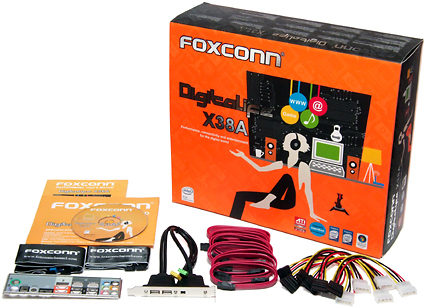X38 Comparison Part 1: DDR2 Motherboards
BIOS And Overclocking
The X38A offers a good variety of overclocking features, but figuring these out requires a bit of hunting and calculation. For example, the DRAM "Speed" for DDR2 modules can only be set to a 667- or 800 MHz data rate under the "Memory Timing Configuration" menu, but a wide variety of alternative ratios can be picked from the "Ratio and Clock Setting" menu. Calculation comes into play when selecting any voltage, as these are listed as "plus" steps based on the original setting.
| BIOS Frequency and Voltage settings (for overclocking) | |
|---|---|
| FSB Frequency | Default - 800 MHz (1 MHz) |
| Clock Multiplier Adjustment | Yes |
| DRAM Frequency | FSB clock x 1.0, 1.2, 1.25, 1.5, 1.66, 2.0 |
| PCIe Clock | 100 - 200 MHz (1 MHz) |
| CPU Vcore | Default - +0.3875 Volts (0.0125 Volts) |
| CPU FSB Voltage | 1.20 - 1.760 Volts (0.080 Volts) |
| Northbridge (MCH) | 1.200 - 1.580 Volts (0.032 Volts) |
| Southbridge (ICH) | Up to 0.424 Volts over stock (0.037 Volts) |
| DRAM Voltage | 1.80 - 2.692 Volts (0.032 Volts) |
| CAS Latency Range | |
| tCAS: 3-10; tRCD: 3-10; tRP: 3-10; tRAS: 9-27 |
We've used DDR2-1066 for previous roundups, but the X38A is missing the "8:5" DRAM:FSB-clock ratio (aka 1.60x multiple) required to set this speed with an FSB1333 CPU. Alternative ratios of 3:2 and 5:3 resulted in DRAM data rates of 1000 MHz and 1111 MHz. We chose the 1000 MHz data rate even though our memory is rated for the higher speed, because doing otherwise would have rewarded Foxconn's oversight with a bandwidth advantage over every other board we've recently tested.
Most likely due to early BIOS problems, the Foxconn X38A suffered from boot failures whenever too many adjustments were made simultaneously in BIOS. This was worse than a typical "crash" because the Port 80 module didn't even light up, indicating that the BIOS failed to initialize. The same issue occurred if too many consecutive changes were made, leaving us to "guess" how many changes to make per boot.
Every change had the potential to create hours of headaches simple to "get back" to a previous configuration without a BIOS initialization failure, and on the third day we simply began taking "shots in the dark" to find the highest stable speed. We were able to complete stability and benchmark tests at a 462 MHz bus clock, but this isn't the board's highest "stable" speed...478 MHz was 100% stable in Windows but a BIOS initialization failure following a late-testing reboot caused us to simply give up.
Three days of fighting BIOS for a good overclock when the remaining boards were overclocked and retested in only one day should be proof enough that our efforts were earnest. We hope to receive an update from Foxconn soon...hopefully before our X38 DDR3 motherboard review is finished since this dual-memory design qualifies for both articles.
Accessories
| Accessories | |
|---|---|
| Documentation & Software | Motherboard ManualQuick Installation GuideMotherboard Driver CD |
| Hardware | 1x 80-conductor Ultra ATA cable, Round1x Floppy Cable6x SATA Data Cable6x Four-Pin to SATA Power Adapter1x Port Breakout Plate (2x USB, 1x IEEE-1394)1x I/O Panel Shield |
The Foxconn X38A installation kit includes a bunch of cables, and even includes six individual Serial ATA power adapters, but not much else.
Most of Foxconn's added value comes in the form of software and utilities on its installation CD. These include Norton Internet Security 2006 and several Foxconn BIOS/Overclocking utilities for Windows.
Get Tom's Hardware's best news and in-depth reviews, straight to your inbox.
Current page: BIOS And Overclocking
Prev Page Foxconn X38A: A Work In Progress, Continued Next Page Gigabyte GA-X38-DQ6: Overclocking Champ-
firesteel What happened to this motherboard? I don't see it for sale at places like tigerdirect. Newegg say it's discontinued. Has it been replaced by a newer model or something?Reply

